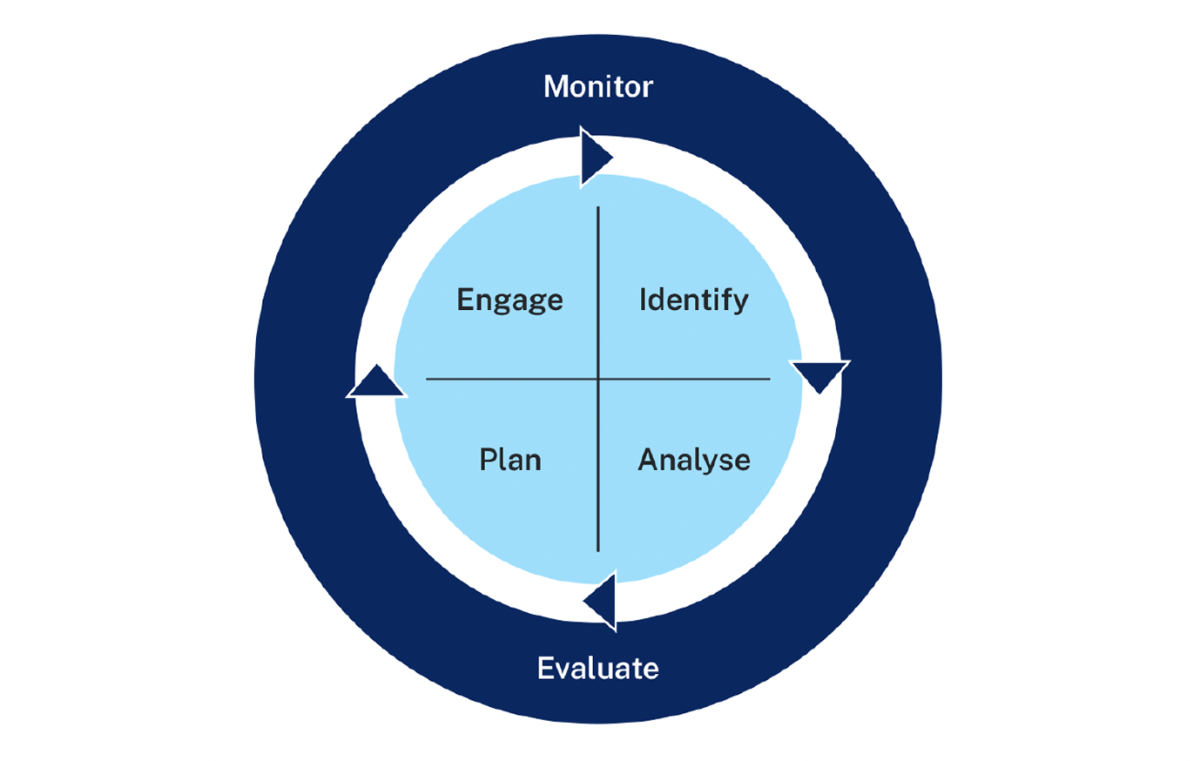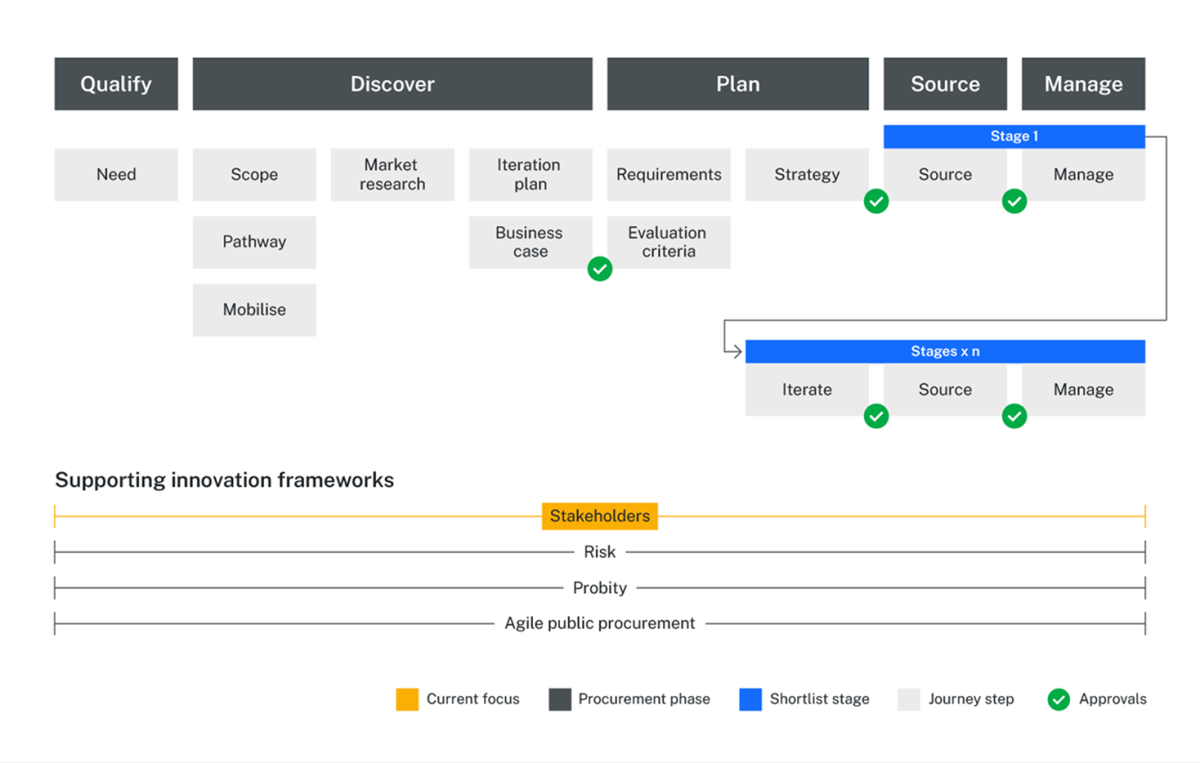Stakeholder management
Identify, engage and manage the experts you need to support your project’s success.

Stakeholders are people with an interest in a policy, project or change. They can include the people affected by the implementation and those with expertise to contribute along the way.
Stakeholder management is the proactive process of identifying and analysing the needs of all relevant parties. It aims to inform, engage and align stakeholders with the goals and objectives of a project. It ensures their contributions are organised and their inputs are monitored to achieve the desired outcome.
‘Stakeholder management' and 'stakeholder engagement' are often used interchangeably. However, the latter is just one of the many tasks associated with the former.
Definition of Stakeholder management framework
A Stakeholder management framework is a structured approach for identifying, analysing and engaging with individuals or groups who can affect or be affected by a project, product or organisation. It provides a systematic process for understanding stakeholder needs, expectations, and influence, enabling organisations to manage relationships, mitigate risks and ultimately improve outcomes. (Source: Agile Alliance)
This page helps buying teams navigate and apply a Stakeholder management framework to support the achievement of these outcomes.
The four key components of the Stakeholder management framework illustrated in Figure 1 below should be continuously monitored and evaluated to track the effectiveness of engagement efforts, making adjustments as needed.
Stakeholder management’s key components are:
- Identify: All individuals and groups who have an interest in, or are impacted by, the project.
- Analyse: Assess the level of interest, influence and potential impact of each stakeholder.
- Plan: Develop specific plans for how to communicate with, consult and involve stakeholders based on their needs and influence.
- Engage: Ensuring clear, consistent and timely communication with stakeholders.
Each component should be monitored and evaluated to ensure effectiveness.
Access Stakeholder framework resources including templates and examples.

Why Stakeholder management is important
Applying the Stakeholder management framework effectively helps buying teams and decision-makers:
- understand the perspectives and motivations of all stakeholders
- maximise stakeholder alignment and endorsement of the buying strategy and outcome
- capitalise on the full value of stakeholder contributions
- effectively balance competing stakeholder interests to ensure the buying project remains on track.
The complexity and uncertainty involved in buying innovation increases the importance of engaging stakeholders as early as possible. This creates understanding and buy-in that set a buying project up for success.
Following a Stakeholder management framework enables buying teams to adopt a structured approach with many benefits:
- Improved project outcomes: By understanding and managing stakeholder expectations, organisations can increase support, minimise resistance and improve the chances of project success.
- Enhanced relationships: A Stakeholder management framework helps build trust and positive relationships with key stakeholders, fostering collaboration and support.
- Reduced risks: By proactively addressing potential concerns and conflicts, organisations can mitigate risks associated with stakeholder opposition or disengagement.
- Effective resource allocation: By understanding stakeholder priorities, organisations can allocate resources more efficiently and effectively.
- Increased transparency and accountability: A well-defined framework promotes transparency in decision-making and accountability for stakeholder engagement.
When to apply a Stakeholder management framework
Stakeholders support every step of the Innovation buying journey. Buying teams should set up to manage stakeholders effectively as early as possible. There are specific actions to either prepare for, or implement, a stakeholder management framework at each phase of procurement.

How to apply the Stakeholder management framework in each phase
Expand the boxes below to learn how to apply the Stakeholder management framework in each phase.
Create a strong foundation for the buying project by engaging approvers early and aligning on the problem, the value of solving it and the benefits of using an iterative approach that supports testing before buying.
During the Mobilisation step, the core buying team should identify all key stakeholders and define their roles and responsibilities. The buying team will also need to determine the types of input required, the nature of engagement with each stakeholder and its frequency to establish cadence.
Stakeholder involvement will ramp up during the Iteration plan and the Business case steps, as both require broad consultation and specialist expertise. A stakeholder's level of interest in, and influence over, a project's outcome will become more apparent during these steps and may need to be reflected in how they are engaged.
The roles and responsibilities determined during the Discover phase should be documented in the buying strategy during the Plan phase.
Before submitting a buying strategy for approval, all listed stakeholders should understand the project objectives and their role. If impacted, they should have had an opportunity to shape relevant aspects and feel comfortable endorsing the project if asked. For this reason, subject-matter experts may need to join a core buying team to contribute to collective decision-making and attend regular meetings.
Stakeholder consultation and contribution is required in preparing market-facing documentation. The buying team needs to confirm the group of stakeholders that will comprise the Evaluation Committee and work closely with them as evaluation stages unfold.
As each Source phase begins, discoveries from prior steps need to be reviewed and reflect any stakeholder changes in stakeholder management structures.
An agile procurement approach can involve multiple Manage phases and, like Source, involves bringing forward prior lessons to iterate upon and shape future steps.
Any changes made during these phase(s) should be managed through clear communication with stakeholders. It should cover what the change is, why it has occurred and any potential impacts relevant to their role or accountabilities.
Key roles and subject-matter experts
Involving the right subject-matter experts (SMEs) at the right time will help buyers access expertise that can save time and improve outcomes. People running a buying project for the first time may find it hard to identify the expertise they need. Sometimes it isn’t clear until it’s too late.
SMEs may need to join a core buying team to contribute to collective decision-making and attend regular meetings. Or the process may only need experts for a specific step. Even where their expertise relates to a specific step, it can be helpful to brief them in advance and give them advanced warning of timelines that apply to their input.
Below is a list of different types of expertise buyers might need throughout a buying project including the kinds of contributions they might make. With this list, buyers can make an informed choice about which expertise is relevant to each unique project and which activities to include stakeholders on.
Early engagement with approvers can save significant delays when it comes time for approval of a buying strategy. Approvers may need to know in advance that an innovation procurement approach is being adopted. They may also need to endorse the investment of more time and resources into setting up the procurement, as well as funding and extra time for trials or other ways of proving potential solutions before committing to one.
Common approvers include:
- Financial delegate (see Financial delegate drop down for more information)
- Chief Procurement Officer or delegate (see Procurement drop-down)
- Chief Information Officer or delegate (See ICT and digital drop-down)
Buyers may also need to consult with, or seek approval from other business units affected by the procurement. We recommend briefing anyone who needs to be part of the consultation or approval on the proposed procurement pathway.
Buyers should identify cyber security experts who can advise on how to meet the mandatory requirements of the NSW Cyber Security Policy and any agency cybersecurity requirements. Uncertainty about the end solution means specific cybersecurity considerations won't be clear at the start of the project. Identifying the right expertise early and briefing advisors in advance are crucial steps. Keeping advisers involved at relevant stage gates will ensure buyers can access advice easily when needed.
Buyers should confirm their financial delegate early using their agency’s delegation manual. The financial delegate will be responsible for signing off on the procurement strategy from the business side, approving spend and entering into agreements with suppliers. Briefing this critical decision-maker on procurement approaches early can help speed up approvals and achieve buy-in at a senior level.
Buyers should consult with central ICT and digital teams within their agency or department early in the planning process to ensure they identify relevant ICT stakeholders. Central ICT or digital teams may be able to provide expertise (or help buyers access expertise elsewhere) on any of the following areas:
- alignment with existing ICT products or an ICT pipeline (the SDA Reuse Policy mandates projects to reuse what is already available)
- alignment with agency or NSW Digital Strategy or roadmap
- digital environment including architecture, technology and constraints
- market analysis including product maturity and leading suppliers
- product-specific expertise such as cloud solutions or artificial intelligence
- digital projects already underway delivering similar digital outcomes
- innovation models and supports or services already available.
ICT and digital strategy teams may also be able to advise on any ICT approvals or governance steps that a project may need to factor in to stakeholder management and timelines.
ICT roles typically consulted include:
- Enterprise architect
- ICT specialist
- ICT business partner
In order for the NSW Government to buy digital solutions, it needs to enter into agreements, which are legal contracts. Planning for this is necessary – even when the end solution is unknown. In innovation procurement, it can be hard to know which agreements to use. This is because the terms and conditions may change with the stages of procurement.
Buying teams can consult the Plan phase guidance on how to approach contracting to help manage this uncertainty, which provides a good starting point before approaching agency legal teams.
Tender documentation also generally involves legal terms and conditions. Engaging with a legal representative early ensures the procurement strategy and business objectives can translate into the appropriate agreements, terms, and conditions. The right governance structures allow this information to be revisited at each procurement stage.
Procurement teams can advise on the best market approaches to meet the objectives of a buying project. They also ensure compliance with NSW Government and agency procurement requirements.
Buyers should confirm the level of procurement sign-off required using their agency’s procurement manual. An agency procurement representative or even the Chief Procurement Officer (CPO) may need to approve a procurement strategy. This depends on the risk and value of the buying project. For innovation procurement, we recommend briefing approvers in advance to avoid delays.
Buyers should also confirm the level of ongoing support and involvement from procurement officers before approvals (and beyond). Innovation procurement can require greater procurement support than projects buying known solutions. Clarifying roles, responsibilities and time commitments early will help procurement teams plan their resourcing, support buyers better and prevent delays.
Procurement roles involved in innovation procurement may vary between agencies and may include:
- Business partner – understands the business unit’s objectives and helps translate them into a procurement strategy.
- Sourcing manager – supports or leads the market approach.
- Procurement officer – supports procurement activity.
- CPO (or their delegate) – approval of procurement strategy.
Buyers should engage a risk, probity or governance subject-matter expert as soon as they know they are adopting an innovation procurement approach. This is because buying innovation creates uncertainty around the end solution. This uncertainty affects evaluation methods and often involves more interaction with suppliers. This expertise can help design a transparent, fair and well-documented procurement process that stands up to scrutiny.
For particularly high-risk or high-value projects, buyers might consider including an independent probity or risk advisor for the life of the project. These kinds of independent advisors serve as a witness to ensure the project follows strong communication, evaluation and governance structures, but they do not replace those structures.
Framing requirements in terms of a problem or a challenge statement, helps attract innovative proposals but also requires a niche skillset. Service designers (or a similar role with an equivalent skillset) are best placed to help shape, frame and define the innovation scope. Their contributions include:
- design and facilitation of problem-shaping workshops
- synthesis of workshop insights
- concise problem framing
- definition of the challenge statement for the Statement of Requirements.
If discovery activities have not been undertaken, service designers can undertake discover lite activity involving workshops with external stakeholders and insight synthesis.
Service designers (or similar role types) are skilled to lead the Mobilisation activities and facilitate workshops. If they are undertaking the Innovation scoping activity, they should take part in project team Mobilisation activities. You should also engage them before the buying project kick-off workshop.
Stakeholder management resources
Define roles and responsibilities for better project outcomes and stakeholder satisfaction.
Identify, engage and manage the experts you need at each step to support your project success.